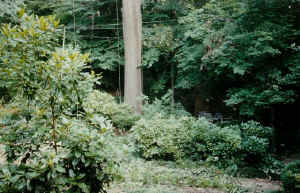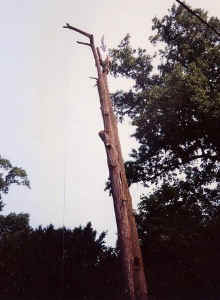ENTS,
Yes, I am guilty! I have killed an old-growth tuliptree. In
fact, in my tree
business I have killed many old-growth trees. Ironically, as
President of
this Society I have probably personally killed more old-growth
trees (and
trees in general) than most anyone on this list. To my surprise,
I am
empowered by the events, rather than being saddened and crushed.
Although I
do not enjoy killing trees, I now have a respect and
appreciation for these
trees that most people do not have. That is why I am here. I am
sure other
arborists and foresters on this list can attest to this feeling,
a feeling
that turns into a moral or ethical practice and forms the
foundation our
professions (those who are professional about it!).
For a change of pace I wanted to relate this story to the list
as a
different view of our eastern big trees. This is a story that
illustrates
the conflicts of the human (urban) and arboreal interface. The
trees often
lose, and at times the loss may be justified when viewed against
a human
life. In this event, the tree lost. But I won a huge lasting
impression that
helped form my professional convictions. Here are the details:
I was working in Maryland for a tree company during the summer
of 1987. When
I rode with my “boss”, Wayne, I often asked what the tasks
were for the day.
When I asked this particular day, he remained silent for a
while, and then
simply replied, “It’s big”. When I asked how big the job
was, he said that
we would be there a few days. I asked how many trees we had to
work on. I
got really worried when he said just one. Since I was the top
climber, I
knew this would be an epic tree if it was to take a few days!

As we approached the job site, Wayne pointed out the top of the
tree rising
above the top of the three-story house. This was when viewed
from the
street- the tree was in the back yard! The other employees and I
opened a
small gate and walked down a sinuous path seemingly carved out
of an ancient
landscape of azaleas and Japanese maples. We were told that the
azaleas were
in excess of 100 years old and the entire yard the winner of
some landscape
contest. It was immaculate, and needed to stay that way. Down in
a ravine
below the ancient landscape was a huge tuliptree ~56” in
diameter. It
towered above all else and was but one in a grove of relic
old-growth
forest. We were there because a hollow 48” diameter northern
red oak next to
it had fallen on the home a few weeks earlier, and this tree,
too, was
believed to be hollow and in danger of falling. As big and
beautiful as it
was, it would slice the house in half if it was to fall, and we
were there
to remove it before it went on its own.

Being a rather novice, but experienced climber, I was nervous
since at the
base the tree was nearly as wide as I was tall! It seemed to
tower higher
than any tree I had seen before. Furthermore, the entire tree
except for a
short section of trunk had to be roped or pieced out in small
sections. The
challenge was the drop zone for the material was a mere postage
stamp in
relation to the size of the tree. Basically, this tree- 4’5 in
diameter,
135’+ tall and 90+ feet wide- had to come down in an area no
greater than
12’ X 20’. And not only was there an ancient prize-winning
garden under it,
but four sets of phone, power and cable lines that for some
reason could not
be dropped. I was nervous!

Drop Zone
We began by throwing ropes over the wires and pulling them back
to clear the
area above the drop zone. I then ascended the tree and set a
rigging rope
high in a lead that was as close to the drop zone as possible.
From this one
point I attached the rope to branch and limb sections and cut
them free. The
sections were then lowered quickly on the rope when they passed
over the
drop zone. The first day was spent getting the lower limbs off.
The next day
I continued to work my way up the crown, removing the huge limbs
as I
progressed up the tree. I was able to get the entire crown out
on the second
day, including the scariest portion- the end of the lead that
the rigging
rope was strung through. As this last piece came off, the tree
and the
skinny portion I was on rocked and bucked while I held on with
tight hands
and various sphincter muscles.

Although I was relieved that the crown was done, I now had to
get the
massive blocks of wood down. Since the tree forked about 40 feet
up into two
leads, I was able to rope the rear portion of the tree out on
the same line
I used to rig the limbs. Some of the chunks were huge, and
required the use
of a 32” chainsaw bar. The remaining trunk, fully 95’ tall,
had to be cut in
pieces into the drop zone without damaging the landscape. This
involved
precision notching and a tagline to guide the pieces as they
came off. Each
piece had to land flat so it did not bounce out into the
landscape. Getting
a piece of wood to land flat takes a combination of a precise
notch and
holding-cut, the correct amount of pull on the tag line, a
“flip” or
restriction of the turn of the wood as it comes off,
compensation for the
length of the piece and the slope of the landing zone, and a bit
of luck. I
had to stand “beneath” some of the larger log sections as
they cracked off
and push up with all I could muster as the log passed over my
shoulder. This
added push helped flip or spin the logs into the correct
rotation so they
would land flat. Fortunately, I had it all that day. Every piece
landed
perfectly and did not bounce. I was immensely relieved to say
the least, and
beamed in satisfaction as the last piece came off and landed
perfectly.
Wayne was impressed, too, as he was the one responsible for
teaching me the
techniques.
Meanwhile, the ground crew was busy moving all the brush and
wood sections
to make room for more. Remember the gate? The ENTIRE tree had to
go through
the gate and onto a truck- including the saw dust. And every bit
by hand. I
did my best to avoid that nasty job, so I was glad to be in the
tree. They
split the larger rounds by hand and wheeled them out in a
wheelbarrow, then
threw them on a truck to be hauled away. Oh how we wished a
crane could
reach over the house to extract the logs! Ugh!

The remaining 40’ or so of trunk was readied to be felled by
making a cradle
of wood for the bulk to land on. It was imperative that the log
did not roll
to the side, as it was being dropped up a narrow path with
azaleas all along
the edges. The log would also have to remain high enough to not
crush the
old bridge directly beneath it. We put cribbing up to elevate
the log after
it fell, and built a cradle of limb wood that would crush and
act as a shock
absorber. If we didn’t, the log could bounce or shatter and
potentially ruin
the landscape we had spent two days protecting.
As I cut the felling notch (face cut) with a 48” bar, I
realized the tree
was hollow. Very hollow. I was worried the hinge would not hold
to guide the
massive log to the cradle. Well, you can’t make more wood, so
we worked with
what we had. The spicy-scented wood was very soft and cut
quickly. The saw
sliced through the back of the tree to the face cut. The trunk
teetered and
groaned, and the hinge held. One more big tug on the tag line
did it. With a
huge crash that brought the neighbors out to investigate, the
trunk slammed
into the cradle, splintering the shock absorber to bits. As the
shrapnel
cleared, the log settled and did not roll. Success!
When my nerves calmed, I looked at the stump. The tree was
entirely hollow,
and a chasm could be made out that extended at least 8 feet
below the cut.
It was too dark to see in very well, so the next day I brought a
flashlight.
Not wanting to drop 8’ down and not be able to get out, I had
some of the
other employees lower me down on a rope. I easily fit through
the hole in
the stump, and when my feet hit the ground I was standing in
water. There
was an underground stream running under the tree, complete with
pebbles and
ripples. The inside of the stump was a “huge” cave that I
could stand and
walk around in. Every major root was decayed under the tree, and
formed
extensions of the cave in all directions. Another
“tributary” of the stream
came down where one root had decayed upslope. In some places
callus growth
was growing in from above to grow around the decayed section of
roots.
Interestingly, there were several sprouts with leaves growing
out of the
callus tissue. These sprouts were a few inches long but were
entirely white!
I wish I had photos of these “cave leaves”. They were so
bizarre- perfectly
formed tuliptree leaves with no chlorophyll at all. Those photos
would have
been great for our tree ID project!
How often do you get to see the inside of a tuliptree? I felt
fortunate for
this experience, and to work on the challenge of “undoing”
centuries of
growth and return a tree to the ground where it started. It was
an
impressive amount of work, and I sure had an intimate
relationship with that
tree after three days of climbing it! Anyway, it took four
people 3 ˝ days
to get the tree down and out of there.
Will Blozan
|